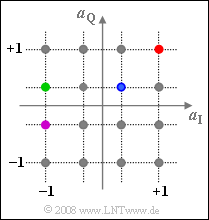Exercise 4.10Z: Signal Space Constellation of the 16-QAM
We now consider the 16-QAM method according to the block diagram given in the theory section. The diagram shows the possible complex amplitude coefficients $a = a_{\rm I} + {\rm j} · a_{\rm Q}$.
As in Exercise 4.10 , the following should be assumed:
- The possible amplitude coefficients $a_{\rm I}$ and $a_{\rm Q}$ of the two component signals are $ ±1$ and $±1/3$, respectively.
- The fundamental transmission pulse $g_s(t)$ is rectangular with amplitude $g_0 = 1\ \rm V$ and duration $T = 1 \ \rm µ s$.
- The source signal $q(t)$ before the serial-to-parallel converter is binary and redundancy-free.
Hints:
- This exercise belongs to the chapter Quadrature Amplitude Modulation.
- Zur Lösung der Aufgabe ist die Seite Quadratic QAM signal space constellations hilfreich.
- The signals belonging to the colored points are shown in the same colors as in Exercise 4.10.
Questions
Musterlösung
- Die Bitdauer beträgt somit $T_{\rm B} = T/4 = 0.25 \ \rm µ s$.
- Damit ist die Bitrate $R_{\rm B} = 1/T_{\rm B}\hspace{0.15cm}\underline { = 4 \ \rm Mbit/s}$.
(2) Aus der Geometrie folgt für $a = 1 + {\rm j}$:
- $$a| = \sqrt{1^2 + 1^2}= \sqrt{2}\hspace{0.15cm}\underline { =1.414}\hspace{0.05cm}, \hspace{0.5cm} {\rm arc}\hspace{0.15cm} a = \arctan \left ({1}/{1} \right ) \hspace{0.15cm}\underline {= 45^{\circ}}\hspace{0.05cm}.$$
(3) Der Winkel ergibt sich wie bei der Teilaufgabe (2), der Betrag ist um den Faktor $3$ kleiner:
- $$|a| = \sqrt{(1/3)^2 + (1/3)^2}= \sqrt{2}\hspace{0.15cm}\underline { =0.471}\hspace{0.05cm}, \hspace{0.5cm} {\rm arc}\hspace{0.15cm} a \hspace{0.15cm}\underline {= 45^{\circ}}\hspace{0.05cm}.$$
(4) Für den komplexen Amplitudenkoeffizienten $a = -1 + {\rm j}/3$ erhält man aus der Geometrie:
- $$|a| = \sqrt{1^2 + (1/3)^2}\hspace{0.15cm}\underline {= 1.054}\hspace{0.05cm},\hspace{0.5cm} {\rm arc}\hspace{0.15cm} a = 180^{\circ} - \arctan \left ( {1}/{3} \right ) = 180^{\circ} - 18.43^{\circ} \hspace{0.15cm}\underline {= 161.57^{\circ}}\hspace{0.05cm}.$$
(5) Das violette Symbol $a = -1 - {\rm j}/3$ hat den gleichen Betrag wie das grüne Symbol nach Teilaufgabe (4), während der Phasenwinkel das Vorzeichen ändert:
- $$|a| \hspace{0.15cm}\underline {= 1.054}\hspace{0.05cm},\hspace{0.5cm} {\rm arc}\hspace{0.15cm} a \hspace{0.15cm}\underline {= -161.57^{\circ}}\hspace{0.05cm}.$$
(6) Für den Betrag sind $N_{|a|}\hspace{0.15cm}\underline { = 3}$ verschiedene Ergebnisse möglich: $1.414$, $1.054$ und $0.471$.
- Dagegen gibt es $N_{\rm arc}\hspace{0.15cm}\underline { = 12}$ mögliche Phasenlagen, nämlich:
- $$ \pm \arctan (1/3) = \pm 18.43^{\circ}, \hspace{0.2cm}\pm \arctan (1) = \pm 45^{\circ}, \hspace{0.2cm}\pm \arctan (3) = \pm 71.57^{\circ}\hspace{0.05cm},$$
- $$\pm (180^{\circ}-71.57^{\circ}) = \pm 108.43^{\circ}, \hspace{0.2cm}\pm (180^{\circ}-45^{\circ}) = \pm 135^{\circ}, \hspace{0.2cm}\pm 161.57^{\circ} \hspace{0.05cm}.$$
